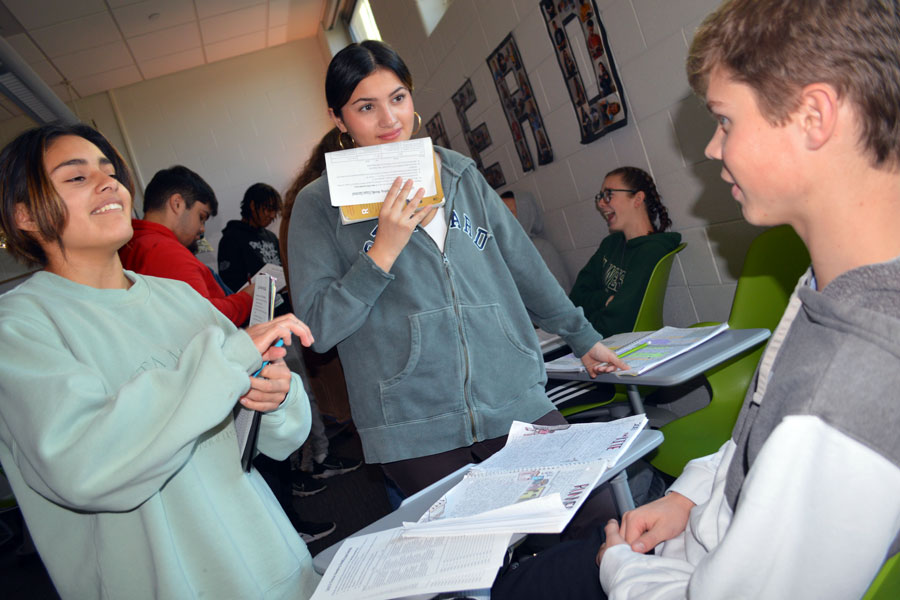Northview — Colin Tebrake thinks a novel way of doing book reports is making him a better reader.
With a two-page spread of notebook drawings and jotted analyses on the desk in front of him, the Northview High School junior recently launched into a detailed synopsis of the Dan Brown thriller, “The Lost Symbol.”
When doing book reports the usual way, “I would read, but I wouldn’t comprehend,” Colin explained. “Now I actually know what’s going on and can explain it to other people.”
Also enthusiastic about the memoir he just finished, “The Unexpected Guest,” was Jonathon Popp, who readily admitted he’s not what he would call an avid reader. But Jonathon also is a fan of the two-page spread, an artistic-style book report that uses doodles, drawings and words as brief explanations to help students present what they have read in a more visual way.
“I do stick figures; I’m not really an artsy person,” he said as he pointed out the grid of typed analysis he’d come up with to better frame his thoughts and the accompanying doodles that illustrated each point. “I definitely think (the two-page spread) helps me understand books better.”
And that, teacher Audra Whetstone said, is educator gold.
“Some of them are literally beaming with pride when they showcase their two-page spread to their peers, and there’s not much better than that in this world of education,” she said. “That’s the good stuff.”
See a collection of students’ two-page spreads in this slideshow.
Reading Like Writers
Whetstone said the effort to make reading and doing book reports more engaging has been going on for many years.
About a decade ago, students had to complete 10 pages of reading notes and observations for every book they chose to read, which once was 12 books a year.
“It was a lot, and I noticed it took a lot of love out of their reading,” she said.
The idea for two-page spreads came last year, when Northview English teachers held a book study of “4 Essential Studies” by Penny Kittle and Kelly Gallagher.
Soon after, Whetstone and her then AP Language teacher partner, Sara Pitt, decided to give it a try with their juniors.
The two-page spread “has been an incredible boost in reading comprehension,” she said, “because now, while students are actively reading their books they are acutely looking for significant quotes and thinking about how they can add/organize it to their two-page spread.”
This year, juniors and seniors in AP Language and AP Literature, the latter of which Whetstone team-teaches with Megan Porter, will complete two-page spreads on at least half of the 10 “choice books” they are required to read.
But Whetstone thinks it can easily be adapted to any grade and reading level. “It’s incredible how much these students inspire one another with their level of creativity and vulnerability to try something new,” she said.
Reading Like Writers
This year, Whetstone said she and her new AP Language teaching partner, Janelle Miles, have been more intentional about forming the requirements of the project to align with the skills and standards set forth by the College Board.
She pointed out that two-page spreads also allow students to “read like a writer” as they gather selective evidence from the text, then add commentary about why that moment was significant to their book or the author’s purpose.
“These are the same skills and language that College Board uses with both AP Language and AP Literature in their standards and scoring rubrics,” Whetstone said. “Looking for ‘significant moments’ as they read is helping them to read beyond the text itself; it helps the student think about the impact of their chosen quotes and have to explain why the author wrote it in such a way.” The process employs the same skills needed for many of the essays students have to write for the national AP exam, she added.
Miles came up with the idea that students present their two-page spreads to one another and score their peers’ presentations. “For me, it’s kind of like a science fair for books, a way for students to show their work,” she said.
As it relates specifically to College Board scoring, students use what that body calls “Line of Reasoning,” to logically structure their spreads to be cohesive and have evidence that flows, so they can present what they found based on the quotes they gathered.
“They are to think about how it was written, and why it stood out to them as a reader,” Whetstone said. “What has really blown me away is how creative and ‘above and beyond’ many of these students have gone with this. They openly admit that it makes a difference in how they read and the books that they choose, and then to see how they influence one another is one of my favorite moments of showcase day.”















